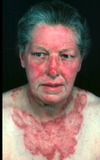Connective Tissue Disease Flashcards
In SLE, who are more commonly affected, men or women?
Women (8:1)
What is the peak age of onset in SLE?
Mid-thirties
What drugs can cause SLE?
Hydrazine and Isoniazid
What is the Mnemonic for remembering how SLE manifests?
SOAP BRAIN MD
- Arthritis
- ANA Positive
- DS DNA Positive
- Seizures
- Pleuritis Percarditis
- Malar Rash
- Discoid Rash

If a patient is photosensitive, what should you always do?
Test for ANA to exclude lupus
What are some cutaneous signs of lupus?
- Butterfly rash - photosensitivity over cheeks and nose.
- Urticarial lesions that are not itchy that last more than 24 hours.
- Vasculitis - if so, always screen for SLE.
- Nail fold telangectasia and splinter haemorrhages.
- Non-scarring hair loss - 50% of cases.
What investigations should be done if SLE is suspected?
- Urine - test for blood and protein
- FBC - thrombocytopenia
- ESR - raised in active disease
- U&Es - renal involvement
- LFTs - hepatitis
- Lupus serology - ANA, dsDNA & ENA
- Complement - low C3 or C4 suggests active disease.
With serological markers, what is quite indicative of Lupus?
Both Positive dsDNA and positive ANA.
What is the diagnostic criteria of SLE?
The presence of any 4 of the following:
- Malar rash
- Discoid rash
- Abnormal photosensitivity
- Oral ulceration
- Non-erosive arthritis
- Serositis (pleurisy or pericarditis)
- Renal disease (proteinuria or renal casts)
- Neurological disease (epilepsy or psychosis)
- Haematological disorder (anaemia, leucopenia, lymphopenia or thrombocytopenia)
- Abnormal serology; ANA, dsDNA
What is the treatment for SLE?
- Immunosupression is the main treatment - this depends on the overall degree of involvement.
- Oral steroids
These all usually are initiated and monitored by a specialist.
What are the 2 main types of lupus?
- Subacute Cutaneous Lupus
- Discoid Lupus
What % of patients with either form of cutaneous lupus go on to get systemic symptoms?
5%
How does subacute cutaneous lupus present?

- Rash on sunexposed areas.
- Often annular
- Some scaling
- Lasts weeks or months.

What does the rash of discoid lupus look like?
What is the cardinal sign?
it is red and scaly.
The cardinal sign is atrophy and scarring.

Can lupus cause scarring?
yes

What are the investigations for cutaneous lupus?
-
Biopsy - remember to look for Immunofluorescence
- On IMF - they will see the LUPUS BAND, IgG and C3 in the dermoepidermal junction.
-
Autoantibodies
- Subacute cutaneous lupus - Usually ENA positive.
- Discoid lupus - negative for autoantibodies
- Screen with ANA, dsDNA & Complement. If positive, these patients are more likely to develop Systemic Lupus.
What are some complications of cutaneous lupus?
- Discoid lupus - can progress to SCC.
- SCLE - if Ro antibody positive - this antibody can cross the placenta causing neonatal heart block and SCLE in the neonate.
What is the treatment of cutaneous lupus?
- Avoid UV exposure
- Oral prednisolone (10-40mg OD) - short term
-
Hydroxycholorquine Oral - 200-400mg daily over summer months.
- This with sunblock helps to reduce lesions in 80% of patients.









